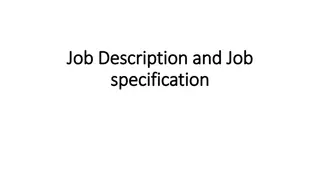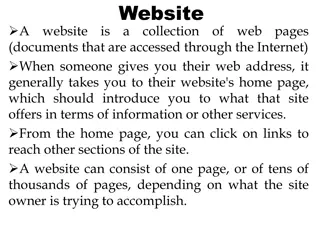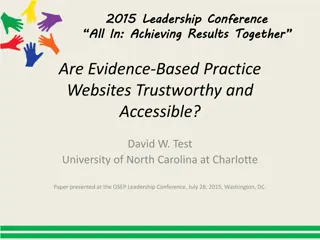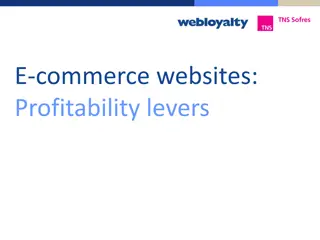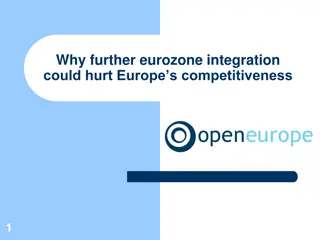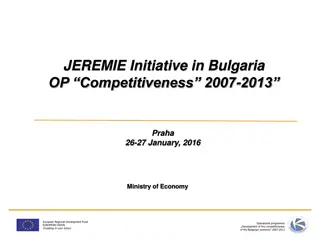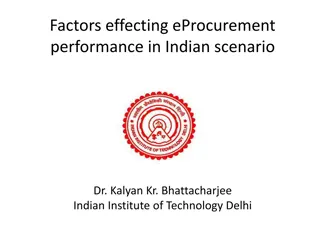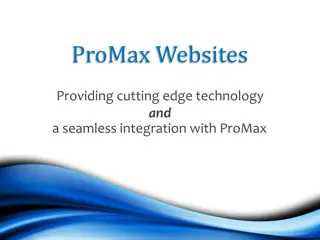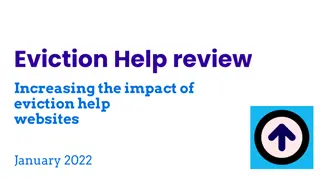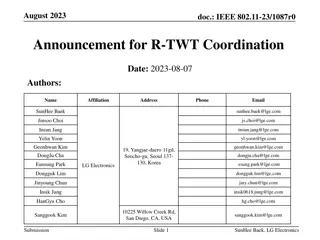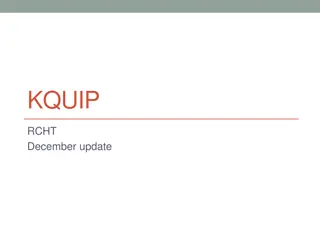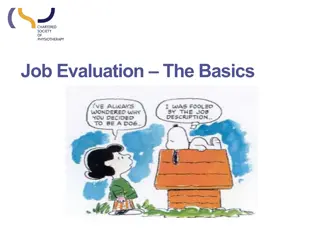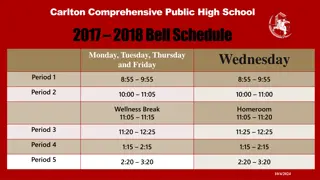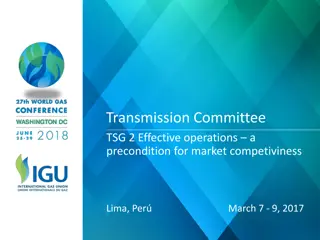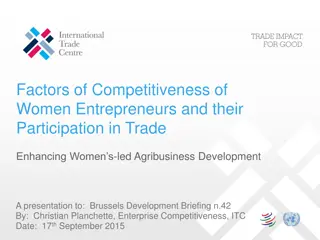Factors Affecting Job Announcement Competitiveness on Job Listing Websites
Factors influencing job announcement competitiveness on job listing websites are crucial for attracting potential candidates quickly. This study explores job seekers' processing of information and how it impacts job pursuit intentions. Theoretical backgrounds on Job Pursuit Intentions (JPI) and Employer Attractiveness (EA) are also discussed to understand factors that affect candidates' interest in potential employers.
Download Presentation

Please find below an Image/Link to download the presentation.
The content on the website is provided AS IS for your information and personal use only. It may not be sold, licensed, or shared on other websites without obtaining consent from the author.If you encounter any issues during the download, it is possible that the publisher has removed the file from their server.
You are allowed to download the files provided on this website for personal or commercial use, subject to the condition that they are used lawfully. All files are the property of their respective owners.
The content on the website is provided AS IS for your information and personal use only. It may not be sold, licensed, or shared on other websites without obtaining consent from the author.
E N D
Presentation Transcript
Factors affecting job announcement competitiveness on job listing websites The whole art of war consists of guessing at what is on the other side of the hill. | Duke of Wellington Zoltan Rozsa, Alexander Dub ek University of Tren n, Faculty of Social and Economic Relations Trencin, SK
Only a very brief moment in the online environment determines whether potential job candidates respond to the job offer, and thus factors influencing the candidate's attention also influence the employer's competitiveness.
Papers Aim Despite the widespread use of the job listing websites for recruitment purposes, little is known about: how job seekers process evaluates presented information (Gregorka et al., 2020; Hinojosa et al., 2015; Priyadarshini et al., 2019; Shahbaz et al., 2019) and which information improve candidates' job pursuit intentions (JPI). To address the mentioned research gaps in the existing literature, the paper aims to determine factors that affect job pursuit intentions (JPI) in the job listing websites environment.
Theoretical background | Job pursuit intentions (JPI) The intention to take steps to gain in-depth knowledge about the organization, establish closer contact with it, and to arrange a job interview (Aiman Smith et al., 2001) or as Arijs et al. add starting to think about an organization as a right place to work. In the early recruitment stage, JPI refers to the range to which persons looking for a job are trying to find out career-useful information about the potential employer (Beenen & Pichler, 2014) or at least have a desire to be included in the organization's list of potential job candidates (Chapman et al., 2005). Moreover, persons who would like to work for an organization will also try to actively acquire more profound knowledge about the organization because of to better succeed in selection procedures (Hinojosa et al., 2015). The first group of scholars declares that job seekers' intention cannot be arbitrarily increased or forced by immediate recruitment campaigns and depends mostly on employer attractiveness (EA). The second group considers that the more specific the information provided to the applicant during recruitment results in higher job pursuit intentions (JPI).
Theoretical background | Employer attractiveness (EA) The extent of how potential applicants perceive organizations as the right places to work (Jiang et al., 2011; Rynes et al., 1991). In the context of this study, it is defined as benefits that are related to the firm's reputation or result from belongingness to a specific group of companies (e.g., sector, familiarity with an organization, reputation, organizational culture).
Theoretical background | The content informativeness According to Maurer & Liu (2007), during the early recruitment phase, the amount and kind of information content (message) presented during the early recruitment stage is the most elementary design components that have to be reflected. Which in practice means that mainly "richness" of available information needs to be considered, and therefore it is a decision as to whether the published information should be detailed or just the cursory.
Theoretical background | The content attractiveness Potential applicants create a mental picture of what the organization is as an employer based on how organizations communicate. Attractive content is often willingly shared and disseminated in online environment. Hence, a more personal, friendly, and sociable way of communication leads to an overall warmer perception of organizations. Further, organizations that provide more compelling information about the job offered are perceived as more competent (Carpentier et al., 2019).
Research objective, methodology, and data | Hypotheses H1: The employer attractiveness (EA) significantly contribute to job pursuit intentions (JPI). H2: Announcements with the detailed information (about H21 employees' responsibilities (IER), H22 salary and benefits (ISB), H23 training opportunities (ITO), H24 security of employment (ISE), H25 working atmosphere (IWA), H26 work-life- balance (IWLB), H27 career opportunities (ICO)) significantly contribute to job pursuit intentions (JPI). H3: The content attractiveness of the online announcement (CA)) significantly contributes to job pursuit intentions (JPI)
Research objective, methodology, and data | Data collection process This study used a quantitative approach through survey research. Data was collected from a sample of Czech (CR) and Slovak Republic (SR) university students. CZ SK Variable N % of Total N % of Total GENX 39 9.47% 19 4.61% With the help of selected faculty teachers, there were identified 1,415 students. GENY 60 14.56% 57 13.83% GENZ 121 29.37% 116 28.16% An email was sent to potential respondents with an invitation and instructions on how to complete the questionnaire. Respondents were also informed about the nature of the study and the intended use of the data. Man 87 21.12% 90 21.84% Woman 133 32.28% 102 24.76% 141 34.23% 104 25.24% Public universities Private universities Full time students Part time students 79 19.17% 88 21.36% 162 39.32% 99 24.03% Four hundred and forty-seven questionnaires were returned with 412 being fully completed (effective response rate 29.11 percent). 58 14.08% 93 22.57%
Research objective, methodology, and data | Questionnaire Based on the previous literature, the questionnaire consisted of 24 questions divided into four parts. The first part of the questionnaire measured employer attractiveness (EA) - 9 questions, second part informativeness and attractiveness of online job announcement - 8 questions, and third part the job pursuit intentions (JPI) - 3 questions. A seven-point Likert based scale was used to measure constructs in the first three parts of the questionnaire. The fourth part of the questionnaire included questions about nationality, gender, generation belongingness of the respondents, and the university's status (public or private) - 4 questions. The questions are listed in the above section, for each variable separately. The respondents' task was to select the exciting job announcement on the job listing sites (CR: https://www.jobs.cz/, SR: https://www.profesia.sk/) and to evaluate it based on the questions (indicators) presented in the questionnaire. Before the administration of the survey, the questions were distributed to several doctoral students. Some revisions in translation to the Czech and Slovak languages were made based on their feedback.
Research objective, methodology, and data | Analysis Multiple linear regression was used to determine which independent variables affect the response or help explain the response. Instead of fitting separate models for each predictor, the first model included all predictors, and the second model also second-degree predictors combinations. The least-squares approach was used to estimate the values of the model coefficients. All calculations were performed in SAS JMP version 15.
Results and discussion | Descriptive statistics Tab. 3 Responses to each measure. Source: authors' calculations Differences according to Std Dev Variable Mean Gender Generation Coutry Employer attractiveness (EA) 3.00 0.96 NS NS NS Informativeness about employees' responsibilities (IER) 4.24 1.25 NS NS NS Informativeness about salary and benefits (ISB) 3.31 1.08 NS NS NS Informativeness about training opportunities (ITO) 2.95 1.08 NS NS NS Informativeness about the security of employment (ISE) 4.22 1.45 NS NS NS Informativeness about working atmosphere (IWA) 3.94 1.39 NS NS S Informativeness about work-life-balance (IWLB) 3.95 1.43 S NS NS Informativeness about career opportunities (ICO) 3.25 1.16 NS NS NS Content attractiveness (CA) 4.99 1.20 NS NS NS Job pursuit intentions (JPI) 5.26 0.90 NS NS NS Notes: S = significant, NS = non significant
Results and discussion | Fitting multiple linear regression models First model: the most important factor is Informativeness about salary and benefits (ISB coefficient estimation = 0.34027165), the least important and even with a negative impact is Informativeness about employees' responsibilities (IER coefficient estimation = -0.2126448) Second model: (Employer attractiveness (EA)-2.99976)*(Content attractiveness (CA)-4.98786) Both models found that: Employer attractiveness (EA); Informativeness about employees' responsibilities (IER); Informativeness about salary and benefits (ISB); and H26: Informativeness about work-life-balance (IWLB)contributes to explaining the variance of the attractiveness of the employer (EA). Informativeness about salary and benefits (ISB) was the most crucial factor in both models. An interesting side finding was that more specific information about employees' responsibilities (IER) lead to lower job pursuit intentions (JPI). We have also proved that the attractiveness of the online announcement (CA) itself does not contribute to the job pursuit intentions (JPI). Still, it acts indirectly by acting on employer attractiveness (EA).
Conclusion In today's digital age, many organizations use online recruitment at least to inform potential candidates about job opportunities or to enable them applying for a job through the web (Mareschal & Rudin, 2011). In light of a growing interest in the use of social media among HR activities, this study set out to answer the question of what factors affect job pursuit intentions (JPI) in job listing websites environment. This study provides several implications for human resource management theory and practice. First, at the theoretical level, it extends the research on factors affecting job pursuit intention (JPI) in job listing websites environment. Second, for HR practitioners, it gives practical instructions about what the announcement of the job offer in job listing websites should contain in order to attract potential job seekers. However, it is also necessary to warn HR practitioners trying to embellish the information provided, because job seekers now have access to many social media resources (e.g., independent web sites, chat rooms, and message boards) that provide additional information about potential employers (Djurdjevic et al., 2019). It is obvious that job applicants will compare these independent sources of information with employers' sponsored. Further research should primarily address the limitations of this work and therefore enhance sample on prospective employees beyond university graduates. Specifically, it could also focus on factors influencing the perception of employer attractiveness, such as organization's prestige, whereas it appears that organizations communicating prestigious awards or labels (such as "Great place to work") are more attractive (Guillot-Soulez et al., 2019). Also, personalization of the job announcements as a factor that attracts more considerable visual attention (Pfiffelmann et al., 2019) should also be addressed.
Thanks for attention!! Assoc. prof. Zoltan Rozsa, PhD. Alexander Dub ek University of Tren n, Faculty of Social and Economic Relations Trencin Studentska 2, 911 50 Trencin, Slovak Republic E-mail: zoltan.rozsa@tnuni.sk ORCID: https://orcid.org/0000-0002-5748-5702









